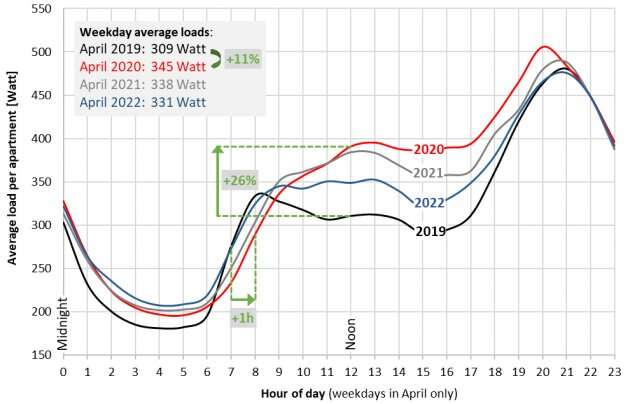Two years into COVID-19, the city that never sleeps returns to waking up early

In 2020, our study showed that lockdowns from COVID-19 significantly increased electricity use in New York City apartments. How has that energy balance changed now that we’ve moved into a “new normal?” Our latest results suggest power usage at home is still higher than before the pandemic—probably due to sustained work-from-home arrangements—but that New Yorkers have shifted back into an early morning routine.
Our findings are based on our Multifamily Residential Electricity Dataset (MFRED), a publicly available database that tracks power usage in 390 apartments in Manhattan. MFRED tracks not only how much electricity us used, but also for what kind of uses (e.g., space heaters vs. electronics).
COVID effects on household electricity consumption differ for different times of day and year. In this analysis, we have specifically looked at daily patterns in consumption on weekdays between April 1 and 28 in 2019 (as a pre-COVID baseline), 2020 (right after the lockdown started in Manhattan), 2021, and 2022. We chose the month of April for this analysis because, in a shoulder season, the impacts of varying weather on electricity use are minimized, thus more clearly revealing the effects we were interested in.
Even as early as April 2020, just weeks after the lockdown went into effect in Manhattan, we observed a 50% increase in the number of apartments that appeared vacant based on their consumption pattern. This reflects the fact that, early in the pandemic, many people fortunate enough to be able to leave their apartment in Manhattan did just that. To correct for this effect in the subsequent analyses, we removed vacant apartments from our analysis (9% of apartments in 2019, 15% in 2020, and 12% and 9% in 2021 and 2022, respectively).
Next, we isolated any general trends in electricity consumption that were not related to COVID. For example, at 10pm—when most people would be home irrespective of stay-at-home orders but often still awake to use lights—we observed a small but systematic drop in energy usage from 2019 to 2022 of, on average, 17 watts per year (3.7% of the 2019 baseline). This downward trend may be related to changes in energy efficiency: if every apartment every year were to replace just one of their incandescent light bulbs with an LED one, for example, this would result in the energy savings we observed.
In the case of the specific apartments in our dataset, some of the downward trend may indeed be due to deliberate interventions: As part of our U.S. Department of Energy-funded research project running since 2016, about 1 in 5 of the 390 apartments in our dataset were receiving a novel form of eco feedback: email messages providing residents with personalized information about their own consumption patterns compared to their neighbors, how this affects the environment, as well as tips and tricks how to achieve savings.
After normalizing for this trend, the total average daily electricity consumption in April 2020 was up by 11% vs. the 2019 baseline, up 9% in 2021, and still elevated by 7% in 2022. Additionally, loads at noon were 26%, 24%, and 12% higher vs. the 2019 baseline for 2020, 2021 and 2022, respectively. This indicates a sustained trend for increased work from home even two years after COVID first hit.
This is consistent with recent survey reports that many Manhattan office employees remain on a hybrid schedule. Consistent with increased work from home, energy usage data at 4am (when loads from electronics in stand-by mode are most prominent) indicated an increased contribution of computers, Wi-Fi routers, etc. to the overall household electricity consumption.
However, while morning load ramp-up was at 7am in 2019, a full hour later at 8am in 2020 and at 7:30am in 2021, in 2022 this ramp-up had reverted back to 7am, just as observed in 2019. It would thus appear that the sustained trend for increased work from home has not been accompanied by a sustained change in household waking patterns, likely because of hybrid working arrangements and return to in-person schooling and education.
While there is an expectation that in-person work headcounts will continue to increase in Manhattan and elsewhere, work-from-home arrangements will carry on increasing household and multi-family residential energy costs. As we enter winter with the threat of steeply rising heating costs, we need to be especially concerned about any potential impacts on households who are already economically vulnerable.
New data suggest COVID-19 is shifting the burden of energy costs to households
This story is republished courtesy of Earth Institute, Columbia University http://blogs.ei.columbia.edu.
Citation:
Two years into COVID-19, the city that never sleeps returns to waking up early (2022, October 27)
retrieved 27 October 2022
from https://techxplore.com/news/2022-10-years-covid-city-early.html
This document is subject to copyright. Apart from any fair dealing for the purpose of private study or research, no
part may be reproduced without the written permission. The content is provided for information purposes only.
For all the latest Technology News Click Here
For the latest news and updates, follow us on Google News.
